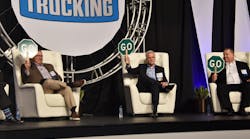This is part one in a two part series on how the proper equipment can help improve driver comfort and safety on the road.
HOT SPRINGS, Arkansas—An array of established and coming truck technologies received across-the-board endorsements from fleet executives in a panel discussion here, but the bottom line is less about equipment cost than about helping drivers be safer, more comfortable, and more productive.
Featured at the recent Arkansas Trucking Association 2021 Business Conference session were John Culp, president, Maverick Transportation; Craig Harper, chief sustainability officer and EVP, J.B. Hunt Transport Services Inc.; and John Smith, president and CEO, FedEx Ground.
Collision mitigation
“Collision mitigation is one of the best things that our industry has ever seen,” said Maverick’s Culp, who praised the automatic emergency braking aspect of the technology. “We've been running it for quite a while, and it is tremendous technology. It will not prevent every rear-end accident, but it absolutely mitigates them.”
While he noted that calculating ROI on “something that didn’t happen” is difficult, Culp reported Maverick trucks were involved in three rear-end collisions in both 2018 and 2019, costing the company $68,000 and $142,000, and had only one such accident in 2020, costing $13,500.
“A rear-end accident is a critical crash—it's one of the most horrific things in our industry,” he said. “The cost of any one of these can go north of a million [dollars], so collision mitigation really saves money. It’s just an awesome technology.”
J.B. Hunt was “getting close” to investing in the technology in 2010, but felt collision mitigation wasn’t quite up to speed—then a truck was involved in a “horrific” rear-end crash that “took the wind end out of the whole company,” Harper explained.
“Maybe you see some technology that isn’t all the way there, but if it's to the point to where you feel like it can eliminate some accidents that prevent loss of life and also protects your driving force, that is something that we felt we needed to jump into, in a big way,” he said. “As we brought on more and more equipment with automatic braking and collision-mitigation systems, we can see that our accidents were going down. It’s really been amazing.”
Harper did note, however, that the technology “is not perfect,” and that drivers have complained about “false alarms,” or incidents where the system will brake for an approaching overpass, for example.
Smith of FedEx Ground also praised the technology.
“To us, it's the No. 1 safety enhancement that has come out over the last few years,” Smith said. "It’s not perfect, but it keeps you from running into someone at 65 miles an hour, versus getting down to 10 or 15 miles an hour.”
He noted that FedEx Ground includes a contract provision for business providers that requires a collision-mitigation system for later model trucks.
“We’re absolutely in support of this—it’s a great thing,” Smith said.
Electronic stability control
Electronic stability control (ESC) systems are “really, really important” for fleet running double trailers, FedEx Ground’s Smith explained. He noted the technology continues to improve and is enhanced by air-disc brakes on trailers.
“When you have to jerk or swerve with a set of pups, that whiplash will cause the back pup to turn over if you don't have [ESC] on there,” he said. “And, along with a telematics system, we have the ability to coach our drivers because of this. Before this technology, we didn't know anything about close calls, unless the accident actually happened. You’d be surprised at how many close calls or events that allow you to coach there are. And that's why it's so important.”
J.B. Hunt’s Harper also pointed to the driver-training benefit.
“We'd love to be riding with the drivers—you can learn a lot,” he said. “But you can't do that. So having a lot of this safety equipment like roll stability, it’s like you do have somebody riding along and you get notified at a critical event..”
That coaching aspect is “incredibly valuable,” Maverick’s Culp agreed.
“The key with any technology is what you do with it,” he said. “Obviously, it works, but if you really want to lever the benefit of it, you've got to use the data.”
Lane-departure warnings
Smith suggested that multiple lane-departure warnings over a short period indicate the driver is not focused on the road. He also highlighted the importance of having a good safety analytics team to monitor and understand the data.
“The No. 1 killer on our highways is distracted driving,” he said. “So if a driver has seven or eight lane-departure events in five minutes, one of two things are going on: They're on their cellphone or they're distracted by something in the cab, or they are getting sleepy.”
Patterns emerge when the lane-departure data is analyzed by the time of day, or how long a driver has been behind the wheel, he added.
“If drivers start getting tired or drowsy at that same time we encourage them to do something different,” Smith said. “Because this lane-departure pattern is telling us that if you keep doing that at this time, you're eventually going to have an accident.”
Culp agreed, and he again pointed to the driver-training advantage of the lane-departure alerts.
“Sometimes, drivers have multiple lane departures, and it gives us the opportunity to work with drivers to make a difference,” he said. “It's a great example of having a great technology, but you have the data and information that lets you really take it a step further; it's really productive.”
While the lane-departure alerts are “great,” Harper noted that J.B. Hunt is still evaluating lane-keeping technology.
"I don't know [that lane-keeping technology] is ready—plus, the driver can turn it off,” he said.
Camera systems
Maverick’s Culp opened discussion of inward- and outward-facing cameras by showing video of driver trying to manage three rambunctious children playing in the sleeper while he was on the road. While he was on the phone. Without a seatbelt.
“It’s embarrassing to show, but I thought it was a great example that you just don't know what's going on with your driver and your truck,” he said.
But seriously, Culp called forward-facing cameras “the biggest no-brainer” in trucking.
“It has been the easiest payback of any technology we've ever put on the truck, hands down,” he said. “It has been a really good thing to clear us in he-said, she-said situations and accidents. It also is just a great, great tool when you're evaluating an incident and a driver tells you something happened but you watch on the video and that's not exactly the way it happened.”
Maverick has installed forward-facing cameras on essentially the entire fleet, Culp reported. The company is still evaluating inward-facing cameras. Driver resistance is the preliminary sticking point.
“So we had to approach it from the standpoint of explaining to them why we're doing it,” he said. “The inward-facing camera gives us the ability to work with drivers; we want to find out when things are going the way they're not supposed to, kind of like in the video.
“There’s a theme here of using technology not as punishment, but for improvement,” Culp continued. “We’re going to work with you to help you understand how to be safer. It's better for you; it's better for your family; it's better for your career; and it's absolutely better for the motoring public.”
J.B. Hunt has used forward-facing cameras “for some time,” and the system has exonerated drivers in numerous incidents, Harper explained.
“It was crazy: When we first started using cameras, I couldn't believe people would have cars pull over on us, on the interstate, and slam on the brakes,” he said. “So we're big fans of the forward-facing cameras.”
The company has recently installed 500 driver-facing camera units, Harper noted, with the aim—again—to identify risky behaviors and teaching opportunities.
“We did get some resistance from drivers at first, then after a while they see there’s a benefit to having these cameras coming in and protecting them,” he said. “You’ve got to get used to some of these alerts and noises and lights. But, day in and day out, I think drivers understand that this technology is indeed for their own good. We don't bring this out to irritate or harass them. We see how the equipment works and do our evaluations and make the decision that, yes indeed, things will be better for the driver.”
Smith added that only a “very small percentage” of drivers “really, truly” complain. He quipped that before cameras, drivers often blamed incidents on an animal in the road—then suddenly the animals disappeared.
“The first thing that we found out [when we installed cameras] was the drivers went to sleep, or they were distracted,” Smith said. “That's why they ran off in the ditch. It wasn't deer.”
Virtual onboarding, training
While the pandemic has brought virtual driver interviews to the forefront, Smith suggested “this is the future” with a younger generation that is comfortable with technology. More important will be virtual or remote training—both for drivers and technicians, he added.
“It's been absolutely huge for us,” Smith said. “The ability to have a mentor that works in the Chicago shop that trained this person who now works in the Kansas City shop, to work on the same thing with a FaceTime-like video on their laptop.
“The same thing goes with our driver-training programs. Whoever coaches and trains that driver keeps in touch with them as they go throughout their career. So it's a combination and you need both, but as we go forward this virtual training is getting better and better.”
J.B. Hunt began using virtual training even before COVID-19, and “it’s fortunate we did,” Harper noted.
“It's been a benefit for us and for the incoming drivers in,” he said. “It does not eliminate the need to do some training in person and with actual equipment, but it is nice to be able to knock out a lot of the time-consuming tasks—like the forms all these new drivers have to fill out.”
Additionally, the company now makes quarterly safety training available online, meaning the driver and truck don’t have to come in from the road.
Flatbed specialist Maverick uses virtual training tools, for example, when a customer changes loading procedures, Culp explained. A video of the procedure will be available online, so if it has been weeks or months since the driver was initially trained before he of she visits that customer, the procedure can be reviewed in the cab.
“It doesn't replace one-on-one training and it doesn't replace group training, but it is an incredibly valuable tool to use to be more efficient and to provide great training,” Culp said.
This is part one in a two part series on how the proper equipment can help improve driver comfort and safety on the road.






